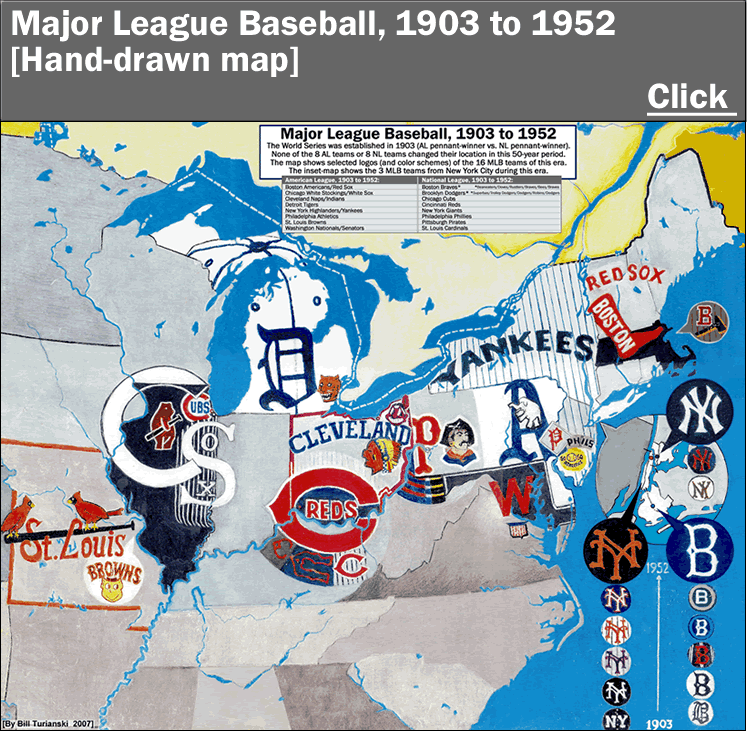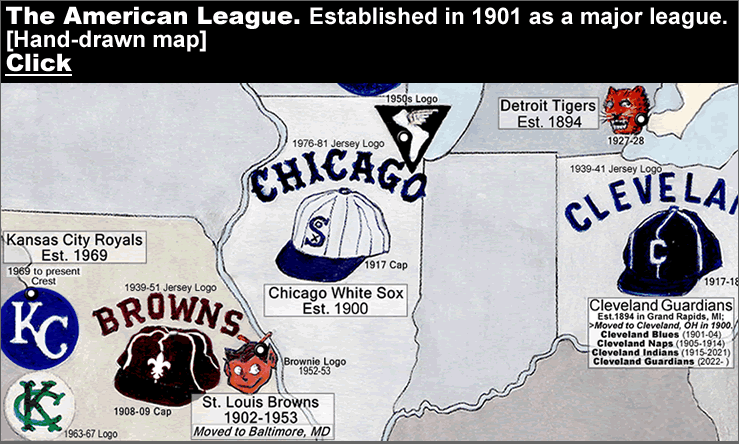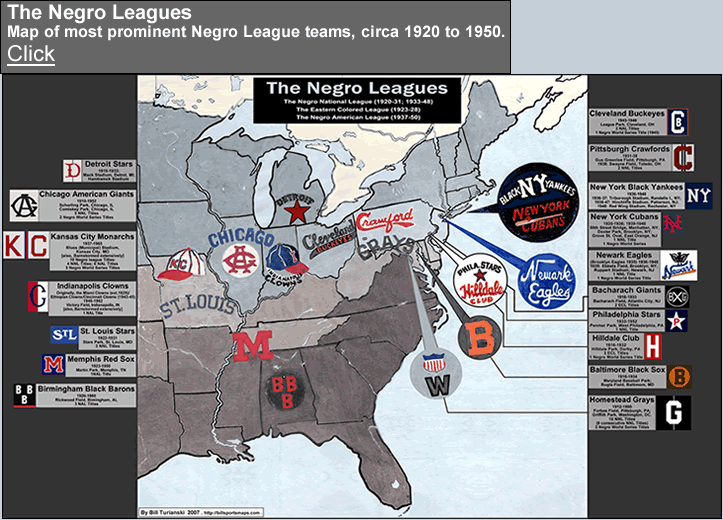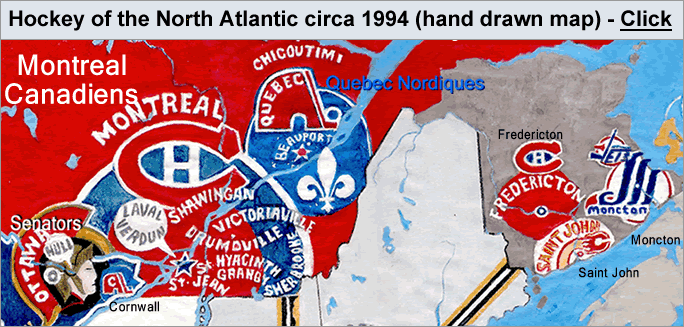So to mark the 15th anniversary of my site, I am posting a series of maps from the early days of this blog. Here, I am re-posting my first-ever post {originally, here}. It is a hand-drawn map of the early days of the NFL. This map shows the prominent NFL teams of the period from 1920 to 1960.
NFL 1920 to 1960 [hand-drawn map]
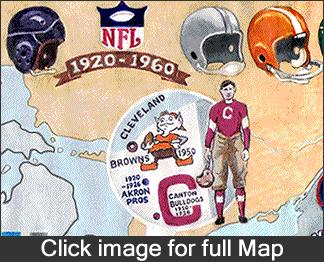
There are 35 teams shown on the map. The criteria I used to determine which teams to include on the map, and which teams to leave out, was this: a team (franchise) had to have played at least 4 NFL seasons. So the map shows every NFL team which was established between 1920 and 1960, and which existed for at least 4 seasons.
Franchise shifts are shown as well, with arrows indicating the franchise relocations. Those franchise relocations I showed on the map are:
1) 1921: Decatur Staleys move from central Illinois, up to Chicago, to eventually become the Chicago Bears in 1922; 2) 1934: Portsmouth Spartans move from southern Ohio, up to Detroit, to become the Detroit Lions; 3) 1937: Boston Redskins move from Massachusetts, down to the nation’s capital, to become the Washington Redskins; 4) 1946: the reigning 1945 NFL champions the Cleveland Rams move all the way out to the West Coast, to become the Los Angeles Rams; 5) 1960: the Chicago Cardinals move down to Missouri to become the St. Louis football Cardinals.
The evolution of the football helmet is depicted at the top of the map. The 6 helmets shown at the top of the map are, from left to right:
1) a generic plain leather football helmet from the late 1910s/early 1920s; 2) Green Bay Packers yellow/gold-painted leather helmet (with multiple round air vents) circa late 1930s; Chicago Bears navy-blue-painted padded leather helmet from the 1940s; 4) Detroit Lions silver-painted plastic-shell helmet from the early 1950s; 5) Cleveland Browns orange plastic helmet with white center-stripe from the early 1950s; 6) Philadelphia Eagles green plastic helmet with silver eagle-wing decal and facemask circa late 1950s.
Other images of note on the map:
Helmets shown on the map:
A) New York Giants dark-blue leather helmet with red-painted sunburst design from 1929; B) Philadelphia Eagles green leather helmet with wavy silver/white painted top section [aka the feather helmet], from 1942 to ’48; C) Los Angeles Rams dark-blue leather helmet with yellow/gold hand-painted rams’ horns design (made and painted by Rams’ Halfback Fred Gehrke) [which was the first helmet-logo in gridiron football history], from 1948; D) Washington Redskins burgundy plastic helmet with white-&-pale-red feather decal on the back-center of helmet, from 1958 to ’64; E) Dallas Cowboys first helmet, a white plastic helmet with a plain dark-blue star decal and two thin dark-blue center-stripes, from 1960 to ’63.
Players shown on map:
Inset-map of northeastern Ohio at the top of the map: Jim Thorpe in his Canton Bulldogs gear circa 1920, based on a famous photo, seen at his Wikipedia page, here. Central Illinois: George Halas in Chicago Staleys gear in 1921. This is an anachronism I was not aware of when I drew this map: a few years ago the Gridiron Uniforms Database unearthed the fact that the early Staleys/Bears teams wore red, and not navy-blue-and-orange until 1922. The uniform I have on the map wasn’t in use until 1928, and you can see that by scrolling through the first decade of the Bears’ uniform history, here. And finally, the player tossing the ball in the Packers’ logo on the map is not a particular player, but a generic player, and that is based on the team’s primary logo from the late 1950s, here.
The list of the 35 teams shown on the map can be found at the foot of this post.
…
…
The American Professional Football Association was formed in 1920, in Canton, Ohio. The APFA changed its name to the National Football League in 1922. Today, only two of the original 1920 franchises, the Decatur Staleys (now the Chicago Bears) and the Chicago Cardinals (now the Arizona Cardinals), remain as NFL franchises.
The early days of the NFL were marked by franchise instability and public indifference. College football was far more popular, and club finances were further eroded by the onset of the Depression in the early 1930s. Many teams came and went. In fact, there wasn’t a balanced schedule until 1936. In other words, for the first 16 seasons of the NFL, some teams played more games than other teams, and scheduling games was left to the teams themselves (and not the league). The roster of defunct NFL teams would startle the average NFL fan of today. Very few fans who cozy up to their TV each autumn Sunday to watch pro football know that in the early 1930′s, New York City boasted three NFL teams: the New York football Giants, the Brooklyn football Dodgers, and the Staten Island Stapletons (NFL, 1929-32). Or that the list of teams that have won an NFL title include the Frankford Yellow Jackets, of Philadelphia, in (1926), and the Providence Steam Roller in (1928). Or that the Detroit Lions, est. 1934, began as the Portsmouth (Ohio) Spartans (1930-33). The league soldiered on through the Depression in the 1930s, and by the end of World War II, the NFL was poised for its future success. The post-War era saw the end of leather helmets in the late 1940s. And the post-Wa era also saw a more emphasized passing game, which helped gain more fan interest. By the late 1950′s, television coverage began turning the NFL into the sports entertainment juggernaut it is today.
To see a list of defunct NFL teams that played for at least 4 seasons, click on the following:
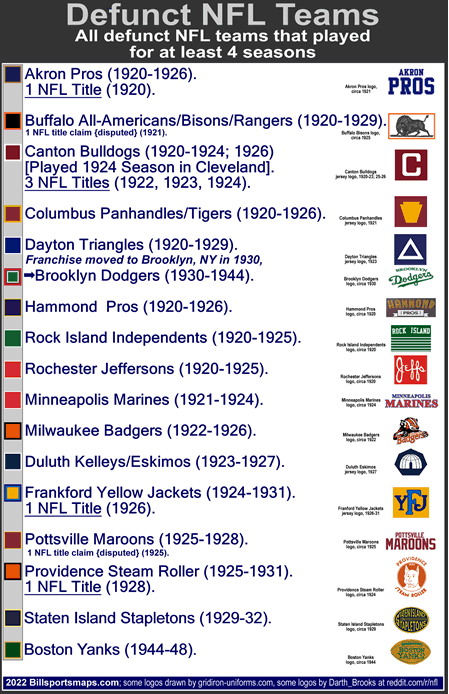
Chart by billsportsmaps 2022; Canton, Columbus, Dayton, Duluth, Frankford logos drawn by gridiron-uniforms.com/[Defunct Teams]; Milwaukee logo by Darth_Brooks at reddit.com/r/nfl/comments/Revising Defunct NFL Teams
…
…
To see a list of all NFL teams (past and present) shown on the map, scroll down to the foot of this post, under the enlarged map below.
NFL 1920 to 1960 [hand-drawn map]
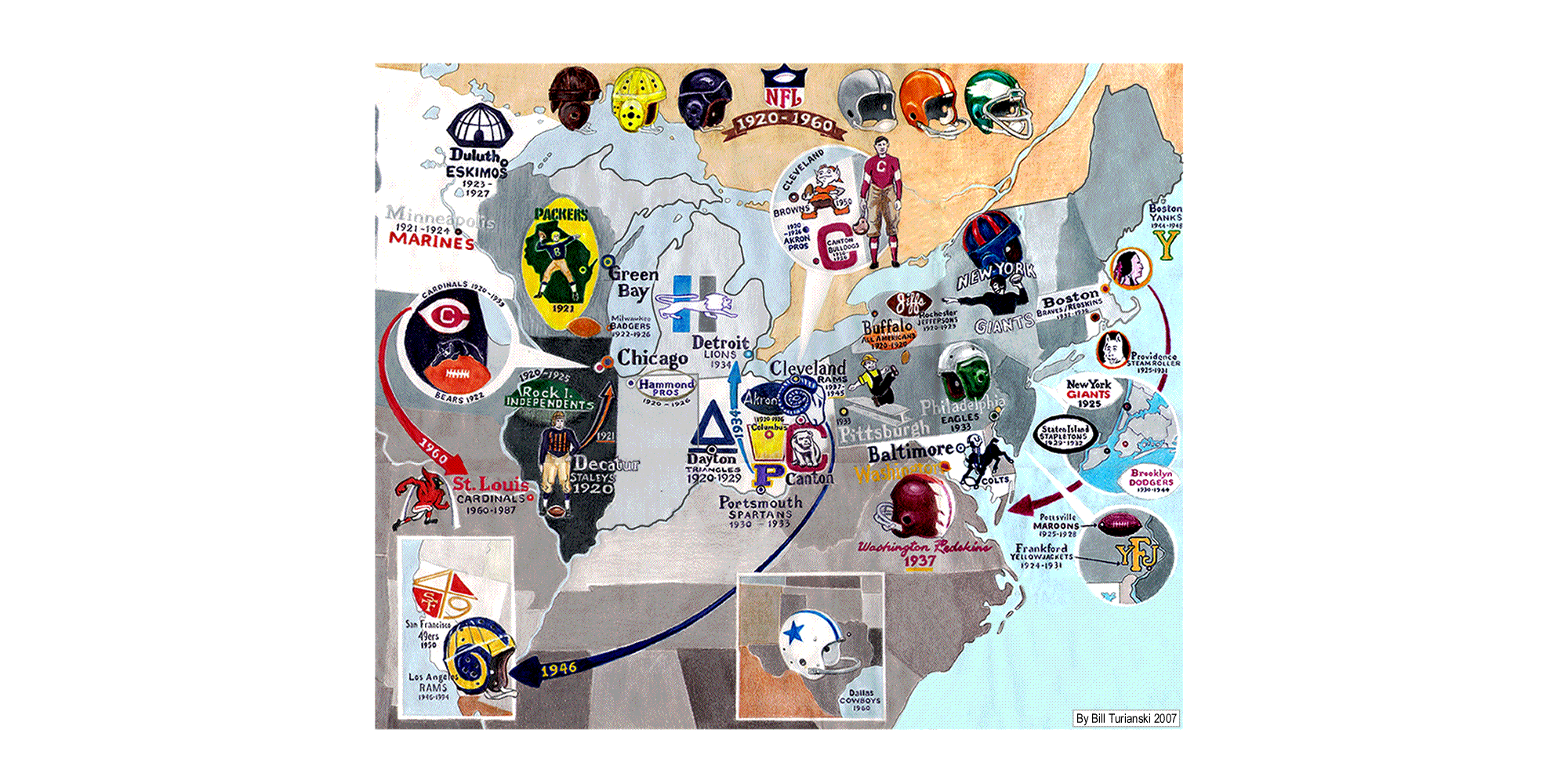
The 35 NFL Teams on the map (which includes every NFL franchise established between 1920 and 1960 which existed for at least 4 seasons)…
[Teams below listed by: years played, alphabetically, with {NFL titles up to 1960 listed} (and with franchise-shifts noted).]
1920 APFA (NFL): 10 franchises est. 1920 on the map…
•Akron Pros, of Akron, OH (1920-26; 1926 as Akron Indians {1920 APFA title}.)/ Defunct.
•Buffalo All-Americans, of Buffalo, NY (1920-29; 1924 & ’25 as Buffalo Bisons; 1926 as Buffalo Rangers; 1928 team suspended operations {1921 disputed APFA title}./ Defunct.
•Canton Bulldogs, of Canton, OH (1920-26; in 1924: played in Cleveland, OH as Cleveland football Indians {1922, 1923 NFL titles}.)/ Defunct.
•Chicago Cardinals (1920-59; 1960: franchise moved to St. Louis, MO as the St. Louis football Cardinals (NFL, 1960-87) {1925, 1947 NFL titles}.)/ Present-day Arizona Cardinals (NFL, 1988- ).
•Columbus Panhandles, of Columbus, OH (1920-26; 1923-26 as Columbus Tigers.)/ Defunct.
•Dayton Triangles, of Dayton, OH (1920-29; 1930: franchise moved to Brooklyn NY, as Brooklyn football Dodgers (NFL, 1930-43; 1944 as Brooklyn Tigers.)/ Defunct.
•Decatur Staleys, of Decatur, IL (1920; 1921: franchise moved to Chicago, IL as Chicago Staleys)./ Present-day Chicago Bears (NFL, 1921- ).
•Hammond Pros, of Hammond, IN [Greater Chicago, IL]/ traveling team (1920-26.)/ Defunct.
•Rochester Jeffersons, of Rochester, NY (1920-25.)/ Defunct.
•Rock Island Independents, of Rock Island, IL (1920-25.)/ Defunct.
1921 APFA (NFL): 2 new franchises and 1 relocated franchise est. 1921 on the map…
•Chicago Staleys, of Chicago, IL (orig. est. 1920 as the Decatur Staleys (1920)/ 1921: franchise moved to Chicago, IL as the Chicago Staleys (1921); 1922: changed name to the Chicago Bears {1921, 1932, 1933, 1940, 1941, 1943, 1946 NFL titles}.)/ Present-day Chicago Bears (NFL, 1921- ).
•Green Bay Packers, of Green Bay, WI (1921- {1929, 1930, 1931, 1936, 1939, 1944 NFL titles}.)/ Present-day Green Bay Packers (NFL, 1921- ).
•Minneapolis Marines, of Minneapolis, MN (1921-24.)/ Defunct.
1922 NFL: 1 franchise est. 1922 on the map…
•Milwaukee Badgers, of Milwaukee, WI (1922-25.)/ Defunct.
1923 NFL: 1 franchise est. 1923 on the map…
•Duluth Kelleys, of Duluth, MN/ primarily a traveling team (1923-27; 1926: changed name to Duluth Eskimos.)/ Defunct.
1924 NFL: 1 franchise est. 1924 on the map…
•Frankford Yellow Jackets, of Frankford, a section of NE Philadelphia, PA (1924-31 {1926 NFL title}.)/ Defunct.
1925 NFL: 3 franchises est. 1925 on the map…
•New York football Giants, of Manhattan, NYC, NY (1925- {1927, 1934, 1938, 1956 NFL titles}.)/ Present-day New York Giants (1925- ).
•Pottsville Maroons, of Pottsville, PA (1925-28 {1926 disputed NFL title}.)/ 1929: franchise moved to Boston, MA as Boston Bulldogs (1929)/ Defunct.
•Providence Steam Roller, of Providence, RI (1925-31 {1928 NFL title}.)/ Defunct.
1929 NFL: 1 franchise est. 1929 on the map…
•Staten Island Stapletons, of Stapleton, NE Staten Island, NYC, NY (1929-32.)/ Defunct.
1930 NFL: 1 new franchise & 1 relocated franchise est. 1930 on the map…
•Portsmouth Spartans, of Portsmouth, OH (1930-33 {1932: lost 1st-ever NFL playoff game to Chicago Bears}.)/ 1934: franchise moved to Detroit, MI as the Detroit Lions (NFL, 1934- )./ Present-day Detroit Lions (NFL, 1934- ).
•Brooklyn football Dodgers, of Brooklyn, NYC, NY (orig. est. 1920-29 as the Dayton Triangles of Dayton, OH/ 1930: moved to Brooklyn, NYC, NY as the Brooklyn football Dodgers; 1944 as Brooklyn Tigers.)/ Defunct.
1932 NFL: 1 franchise est. 1932 on the map…
•Boston football Braves (1932-36; 1934: changed name to Boston Redskins. )/ 1937: franchise moved to Washington, DC as the Washington Redskins (1937-2019; 2020-21:Washington Football Team)/Present-day Washington Commanders (1932- ).
1933 NFL: 2 franchises est. 1933 on the map…
•Philadelphia Eagles, of Philadelphia, PA (1933- {1948, 1949, 1960 NFL titles}./ Present-day Philadelphia Eagles (NFL, 1933- ).
•Pittsburgh football Pirates, of Pittsburgh, PA (1933- ; 1940: changed name to Pittsburgh Steelers)./ Present-day Pittsburgh Steelers (NFL, 1933- ).
1934 NFL: 1 relocated franchise on the map…
•Detroit Lions, of Detroit, MI (orig. est. as the Portsmouth (OH) Spartans (1930-33)/ franchise moved to Detroit, MI in 1934 as the Detroit Lions (1934- {1935, 1952, 1953, 1957 NFL titles} .)/ Present-day Detroit Lions (NFL, 1934- ).
1937 NFL: 1 new franchise & 1 relocated franchise est. 1937 on the map…
•Cleveland Rams, of Cleveland, OH (1937-42; ’44-45) {1945 NFL title}/ 1946: franchise moved to Los Angeles, CA as the Los Angeles Rams (1946-94; 2016- ) {1951 NFL title}/ 1995: franchise moved to St. Louis, MO as the St. Louis Rams (1995-2015)/ 2016: franchise moved back to LA as the Los Angeles Rams)/ Present-day Los Angeles Rams (NFL, 1937- ).
•Washington Redskins, of Washington, DC (orig. est. 1934-37 as the Boston Braves/Redskins/ 1937: franchise moved to Washington, DC (1937-2019; 2020: changed name to Washington Football Team; 2022: changed name to Washington Commanders {1937, 1942 NFL titles}.)/ Present-day Washington Commanders (NFL, 1934- ).
1944 NFL: 1 franchises est. 1944 on the map…
•Boston Yanks, of Boston, MA (1944; ’46-48)/ 1949: franchise moved to New York City, NY as the New York Bulldogs (1949; 1950: changed name to New York Yanks (1951-51)/ 1952: franchise moved to Dallas Texas as the Dallas Texans (1952/ Defunct).
1946 NFL: 1 franchises est. 1946 on the map…
•Los Angeles Rams, of Los Angeles, CA (orig. est. 1937 as the Cleveland Rams (1937-42; ’44-45) {1945 NFL title}/ 1946: franchise moved to Los Angeles, CA as the Los Angeles Rams (1946-94; 2016- ) {1951 NFL title}/ 1995: franchise moved to St. Louis, MO as the St. Louis Rams (1995-2015)/ 2016: franchise moved back to LA as the Los Angeles Rams)/ Present-day Los Angeles Rams (NFL, 1937- ).
1950 NFL: 2 franchises est. 1950 on the map [AAFC/NFL merger of 1950]…
•[AAFC-merger team] Cleveland Browns (1950-1995; 1999- {1950, 1954, 1955, 1964 NFL titles}.)/ Present-day Cleveland Browns (NFL, 1950-1995; 1999- ).
-[AAFC-merger team] Baltimore Colts (I) (1950./ Defunct.) [Not shown on the map.]
•[AAFC-merger team] San Francisco 49ers (1950- )/ Present-day San Francisco 49ers (NFL, 1950- ).
1953 NFL: 1 franchises est. 1953 on the map…
•Baltimore Colts (II) (1953–1983 {1958, 1959 NFL titles}./ 1984: franchise moved to Indianapolis, IN as the Indianapolis Colts (1984- ).)/ Present-day Indianapolis Colts (NFL, 1952- ).
1960 NFL: 1 new franchise & 1 relocated franchise est. 1960 on the map…
•Dallas Cowboys, of Greater Dallas-Fort Worth, TX (1960- .)/ Present-day Dallas Cowboys (NFL, 1960- ).
•St. Louis football Cardinals (est. 1920 as the Chicago Cardinals (1920-59 {1925, 1947 NFL titles}/ 1960: franchise moved to St. Louis, MO as the St. Louis Cardinals (1960-87)/ 1988: franchise moved to Greater Phoenix, AZ (1988- ), as the Phoenix Cardinals; 1994: changed name to Arizona Cardinals.) / Present-day Arizona Cardinals (NFL, 1920- ).
…
___
